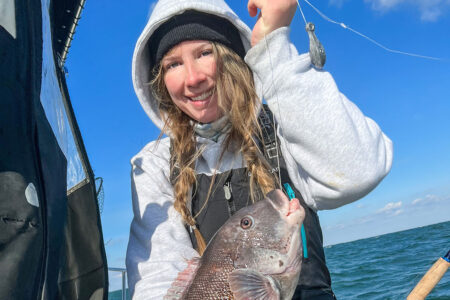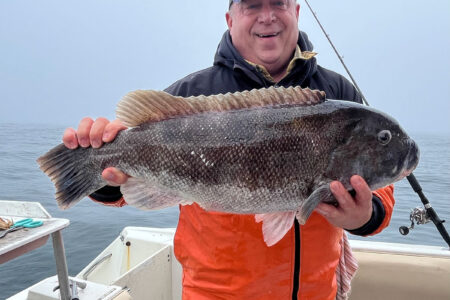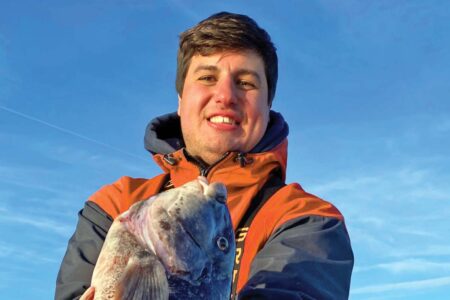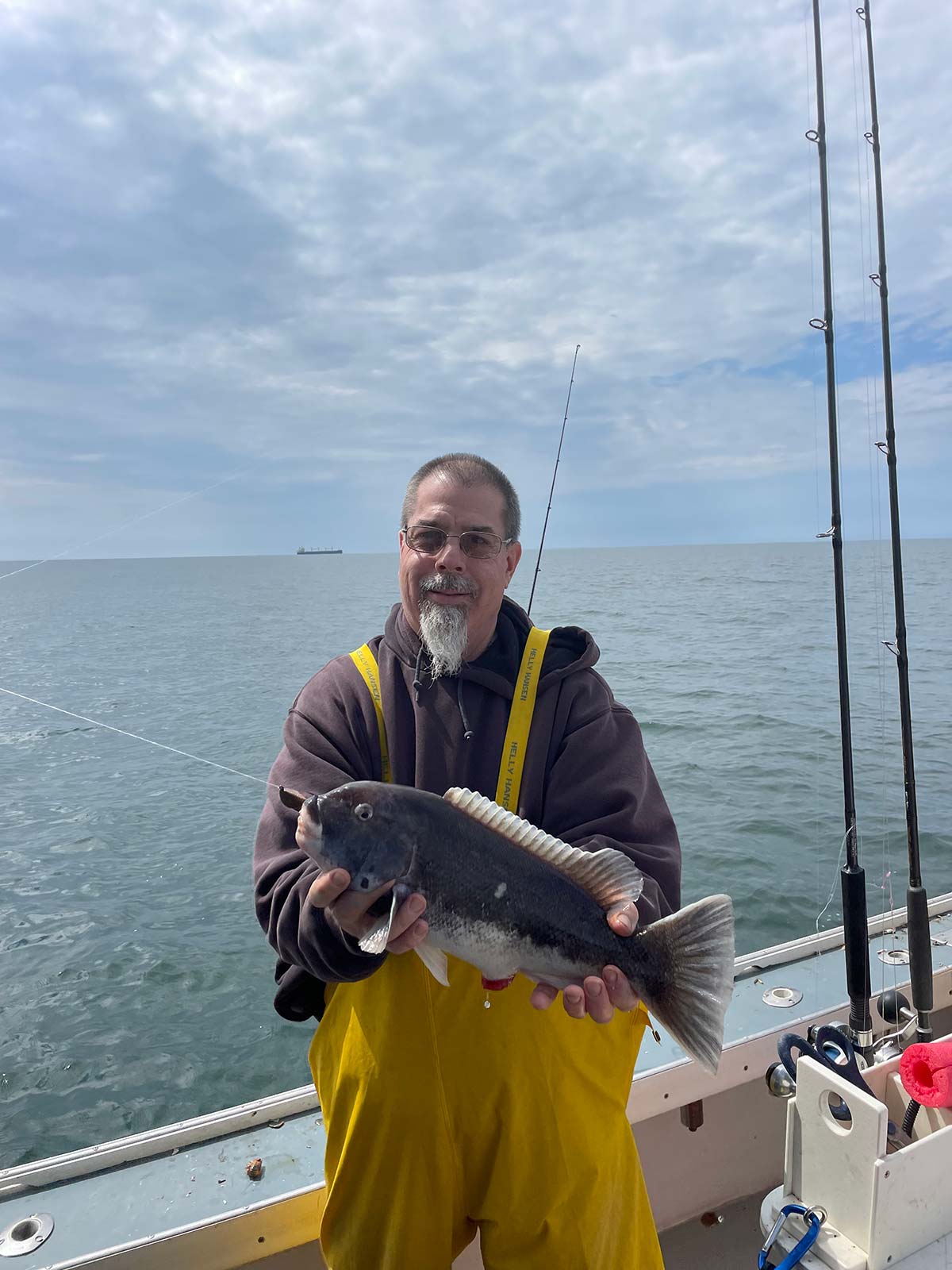
After a March break, New Jersey anglers are back in blackfish in April.
Winter is the giant reset button for most inshore and nearshore species of the Northeast and Mid-Atlantic. Depending on its severity, the cold of winter will drive the sea water temps lower and lower. Surface temps may rise and fall fairly quickly, but a very low water temp for a long winter will plunge the bottom temps as well. The longer the temp stays low, the further and further those low bottom temps will push offshore, and the longer it will take them to warm as spring approaches.
Cold water runoff from melting snow several hundred miles upriver will also drive the water temps down even further. The benefits of a cold winter is a hard freeze of the saltwater in the back bays. During this extra cold period, the bacteria and microorganisms in marine waters will die off, only to reappear when the sun warms in the spring. This deep scrubbing of the backwaters will leave a gin clean water when thawed. Mother Nature is doing her thing.
We have had some odd weather patterns for the past two winters. First was an El Nino, which creates above average temps for us in the Northeast. The year following is usually a La Nina, smaller and not as powerful. Together these systems prevented the plummeting of sea water temps two years in a row which will have blackfish actively feeding through the entire winter season.
When blackfish season reopens again in New Jersey as of April 1, the blackfish will be on the chew, because they never shut down through a milder than normal first quarter. If we did have a very cold-water temps, the fish would sometimes not actively feed until mid-April or so. Every year is different; if you fished every single day, then you would see these changes every day, and maybe follow the bite through different water depths. This is why a full-time charter captain is invaluable to the passionate togger; we depend on the captain who has his finger on the pulse of the day-to-day fishing to take us to where they live.
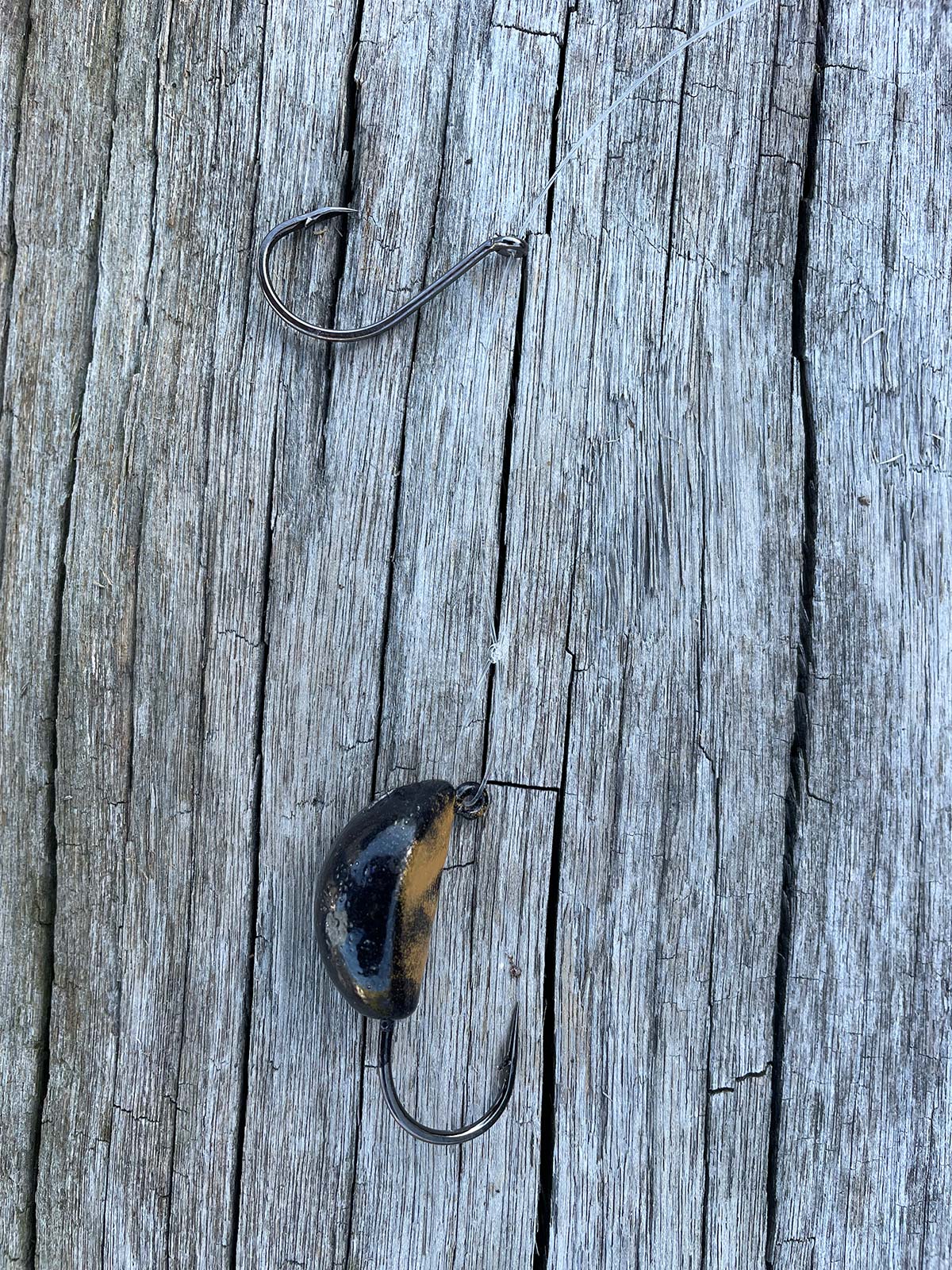
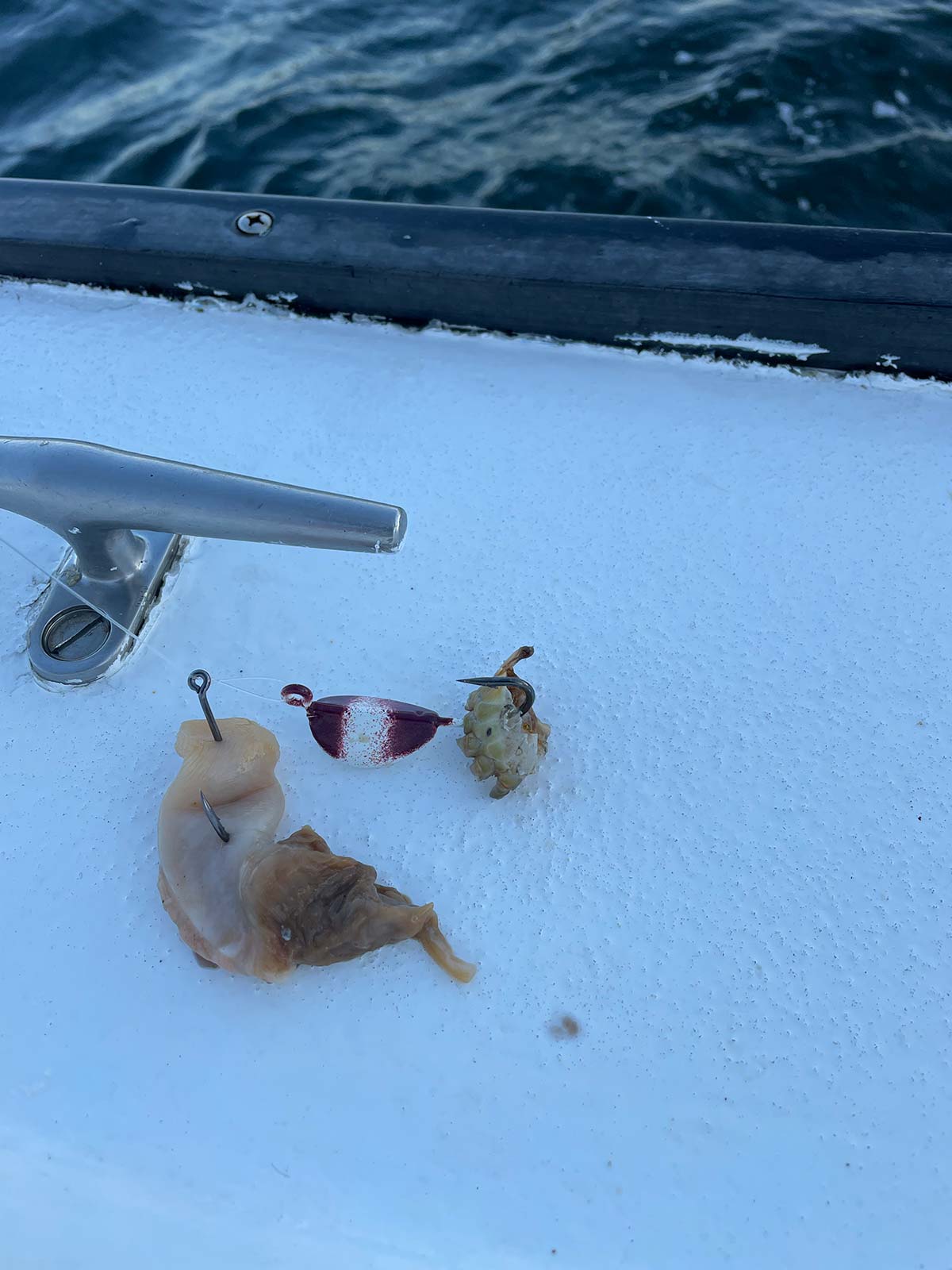
Early Season Blackfish Baits
Truth be told, togging in April is very similar to how it was in January. The fish can be lethargic at times, and it may take some time on a spot to give the fish a chance to find the baits. Then some excitement begins to build life on the wreck as the hungry fish begin to get a bit competitive. Early season will find fish eating crabs, but I often add a strip of clam to get some interest. The fish get the smell of the clam and they give a nibble, then they find a piece of crab under it and they just keep on chewing.
Clam and cooked shrimp are a very attractive meal for these early season fish. Fresh shucked clam is easy to figure why, but the cooked shrimp stays on the hook well and the tog sure will eat them some days. Not sure the true reason why but early season finds blackfish with a bit of a pink mouth, possibly soft and fragile due to their body changing in preparing to spawn. The soft baits are an easy meal for the fish to eat. Try putting a strip of clam or shrimp first, then a half of a greenie with no legs or shell. Give them a meal that’s easy for them to eat.
The only downfall to using soft baits is that they often attract and hold a school of dogfish to the wreck. Dogfish not only eat your bait, but they will also eat the blackfish! When the doggies are thick on a wreck, they will send the blackfish into hiding for their own protection. Other things that will attract dogfish to your bait are a shiny new sinker, or bright colored or glow beads or jigs. Red is the first color to disappear underwater as it descends. If I can keep the doggies away from my bait, I have a much better chance of catching a tog. Wait on a bite extra-long when this occurs. Swing on the blackfish when he is walking off with the bait. If you swing and miss the blackfish, your bait lifts off of the bottom to be noticed by the ever-starving dogfish fleet. The next bite comes quickly. Guess who it is?
This time of year often finds fish moving around the reef sites quite a bit. Each reef site is like a city with many new hiding places for fish to choose from. Depending on the water temp and current flow, fish will shift from one spot to another on each reef site. These same fish will migrate with conditions from one reef to another as well. You may have to try different depths and structure until you find good action. The exception to this is when we are speaking of very large fish on offshore wrecks. These fish live here and they don’t move around as the bottom water temps don’t change much. These fish spawn here as well. This tautog family often has a large dominant male, with other large male and female fish as well. They seem to have a “Bull and Harem” type of arrangement as they will spawn right there on their home wreck. The female swimming toward the surface rolling as several males nudging them all the way.
When we catch these fish, they are removed from the wreck, and may take years for another fish to move in, or perhaps the smaller fish grow into a larger model. To stay on a piece all day and wait out one jumbo, you might be picking that piece completely clean with no more good fish for the next 10 years. Keep that in mind when you’re wondering how many blackfish to box up this month on your trip to the wreck.
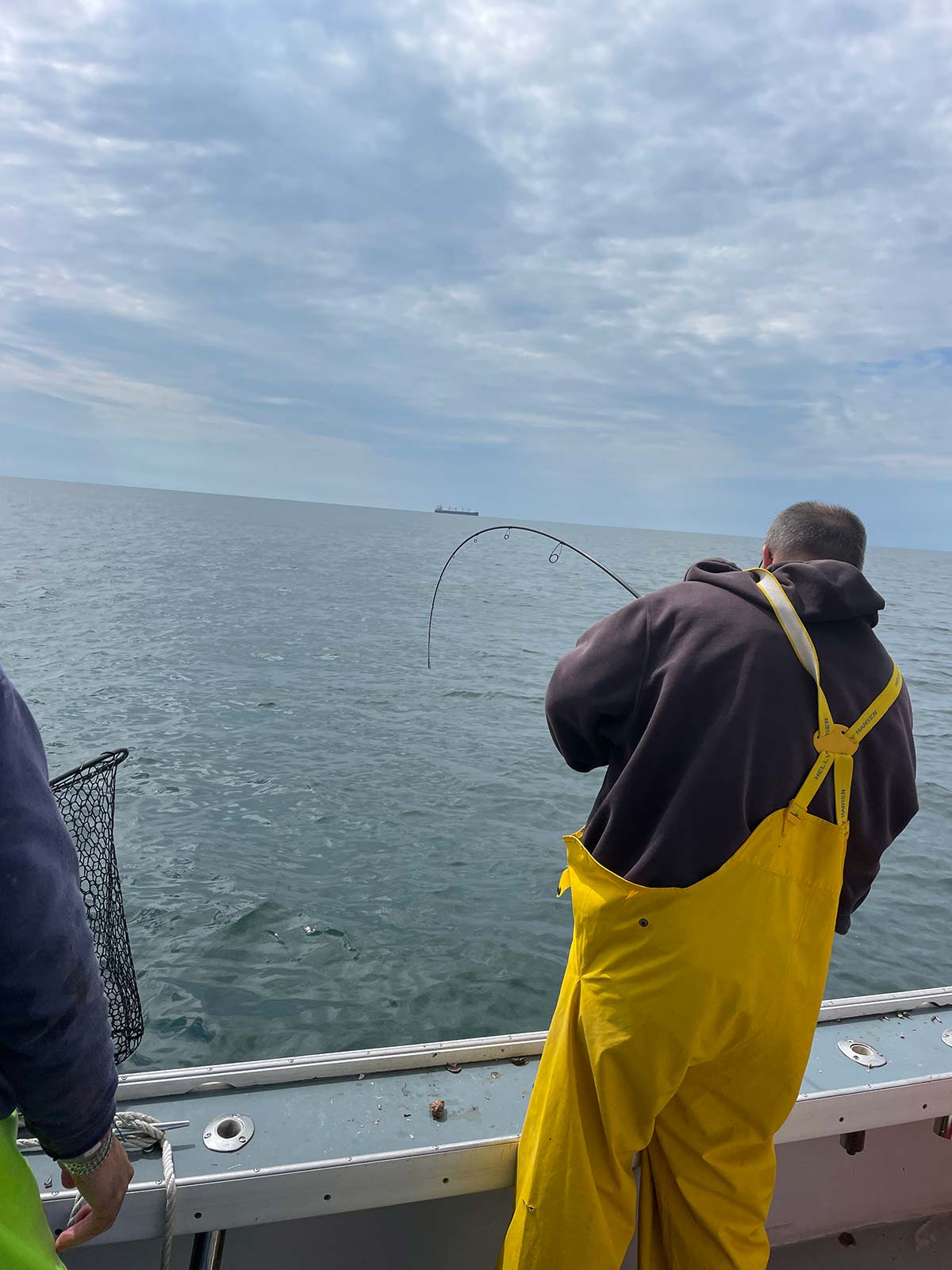
Rigging Or Jigging
There are certain spots where I prefer to fish a jig; primarily lower profile pieces in less than 100 feet of water like rocks or concrete rubble. I try not to let it roll very much as it will get hung in short order in this nasty stuff. Normally 1- to 2-ounce jigs are where I want to be weight wise. Look for a nice feel for the bottom without the jig dragging much due to bottom current or surface waves. I normally drop a slider hook on my leader so that it rests on the top of the jig. Both the jig and the hook get a half of a green crab and a piece of clam. Some people tie a snelled hook directly to their jig hooks eye. I find this gets snagged more often on the bottom, but it also sometimes fouls on your leader as it falls to the bottom.
As far as a togger goes, I admit that I have a unique focus. You see, I don’t want to catch a lot of blackfish, as I am always looking for a jumbo! That being said, my gear is not overly light; “Don’t bring a knife to a gunfight” comes to mind. My jig rod is a Century Weapon MagTaper, almost 8 feet long. I use 20-pound Daiwa JBraid 8 on a Daiwa BGMQ 4000 reel, with a 6-foot leader of 50-pound Tsunami Pro Fluorocarbon. And my drag is tight.
So, what is “the right bite”? Either several good tugs, or the fish just picks up the jig and he swims off with it. Either way, when you are going to swing, hit them hard! Get as many turns on the reel handle before lowering your rod, and move the fish away from the bottom before he realizes that he’s in trouble and tries going the wrong way. What you do in these first few seconds of this battle will help dictate the outcome.
Once the boat is tight on the strings, you can begin to access the bottom conditions. Wind and surface waves usually come from the same direction at the same time, but this varies with how the boat sits on the piece. Surface current and bottom current come from the tidal influence in your area, and these factors can play hell with your jig. This is the reason that one side of the boat may be catching well on the jig, while the other struggles.
| TRI-STATE REGS |
| In Delaware, the tautog season is open from January 1 through May 15, and July 1 through December 31 with a four-fish bag and 16-inch minimum size limit.
In New Jersey, the open tautog season runs from January 1 through February 28 (four fish), from April 1 through April 30 (four fish), from August 1 through November 15 (one fish) and from November 16 through December 31 (five fish) with a 15-inch minimum size, New York separates its tautog limits front to back, with a 16-inch minimum size and season running from April 1-30 (two fish) and from October 11 through December 9 (three fish) on Long Island Sound, while the New York Bight has an April 1 to 30 season (two fish) and a second opening of October 15 to December 22 (four fish). For more information on state-by-state regulations go to www.thefisherman.com/marine-regulations. |
If possible, try to fish the side of the boat that the current is moving away from you on. This small change will impact the amount of “bow” in your line letting you feel your jig without dragging on the bottom so much that you get snagged constantly. Less of a bow also means that you feel the bite much better. When you set the hook, you move the fish away from the structure, so when you whack one and get him on the reel, you have a better chance of landing your fish.
Fish caught on the jig often don’t go through the same stresses that a fish on a rig will. Because they come up more slowly, they are often much better candidates for a healthy release. My crew normally releases all double-digit fish after a picture, so long as they are in good shape. We also try to release all females if they will go. Do what you can to conserve our favorite fish!
Fishing a rig this time of year also gets the job done, especially on a higher profile piece or if I am on the up-tide side of the boat. By fishing more vertically (straight up and down) I also have a chance to limit the fish’s ability to get me into the tall structure. A slider rig with a strip of fresh clam on each hook, then a half a green or small white crab is my bait of choice here.
Best of luck this month my fellow toggers!

